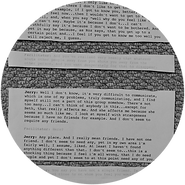WHAT ARE OTHER PEOPLE LIKE WHEN THEY ARE THEMSELVES - PART 2 - THE SCRIPTS
As the ReadThrough script is quite long and consists of five characters I had to make further edits before implementing it in What Are Other People Like.... I decided to modify the scripts to allow for varying numbers of participants and durations.
- Script 1 (yellow) running time of roughly 1 min 40 secs – The shortest of all four scripts. 1t concentrates on the character of Jerry and a dialogue with the facilitator Carl Rogers. As Carl Rogers is always played by the artist this script allows the installation/performance to function if only 1 participant is involved.
- Script 2 (blue) – running time of roughly 3 mins 30 secs - This script introduces another character (Roz) so that the main dialogue is now between Jerry and Roz.
- Script 3 (green) – running time of roughly 4 mins 35 secs – Carlene is introduced and there are now three characters, along with Carl, involved in a conversation.
- Script 4 (pink) – running time of roughly 6 mins – This script has the full ensemble of characters, as it now includes Beth also, and is the longest in duration. It is only in this script that the encounter group of Journey Into Self is fully realised, similar to the broadcast of Paid Opportunity part 2.
All four scripts are attached to a clipboard on every chair. After part 1 of What Are Other People Like... I Am aware of how many participants (ranging from 1 to 4) will be involved in the reading and once everyone is seated I can instruct them on which colour script to refer to. Having the four scripts enables the installation of What Are Other People Like When They are Themselves to function under the many variables and possible scenarios of an exhibition. Aside from the gallery, having the four scripts also gives the work many dimensions in terms of the different sort of encounters it can produce. The performance can fluctuate between the intimate situation and the group situation, emphasising this flux between the individual and group and how this affects behaviour.

